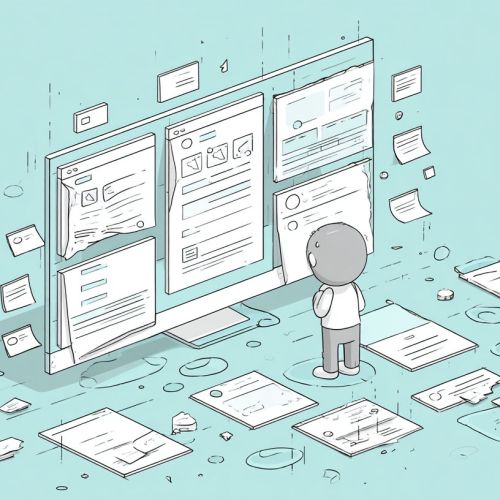The AI revolution is rapidly transforming our world. From healthcare to entertainment, AI’s influence is expanding daily. Yet, alongside its remarkable potential, AI brings significant risks. Understanding these threats is crucial as AI continues to integrate into various facets of our lives.
In 2024, AI advancements are more pronounced than ever. Innovations in generative AI, robotics, and autonomous systems are pushing the boundaries of what machines can do. Companies are increasingly adopting AI to streamline operations, enhance customer experiences, and drive new business models (MIT Technology Review) (IBM – United States). However, this rapid adoption also heightens the potential for significant challenges.
This article will explore four major threats posed by the AI revolution: job displacement, ethical concerns, security risks, and the potential loss of human control. Each section will delve into these issues, providing a balanced perspective on the risks and possible mitigation strategies.
Let’s begin by examining how AI might displace jobs, altering the labor market and impacting millions of workers globally.
Threat 1: Job Displacement due to the ai revolution
AI is transforming industries at an unprecedented pace. Automation and AI technologies are reshaping the job market, threatening many traditional roles. Understanding these changes is crucial to prepare for the future.
The Scope of Job Displacement
AI is automating tasks across various sectors. In manufacturing, AI-powered robots handle assembly lines, reducing the need for human labor. In the service industry, chatbots and automated systems manage customer service inquiries, diminishing the demand for human agents (IBM – United States) (McKinsey & Company). Even in white-collar professions, AI is performing tasks like data analysis, legal research, and financial forecasting, areas traditionally managed by skilled professionals (AI Index).
Examples of Affected Jobs
- Manufacturing: Robots and AI systems increasingly handle assembly and packaging tasks.
- Customer Service: AI chatbots and virtual assistants manage customer inquiries and complaints.
- Transportation: Autonomous vehicles threaten jobs for drivers in trucking and delivery services.
- Finance: AI algorithms are automating trading, risk assessment, and financial analysis (MIT Technology Review) (IBM – United States).
Socioeconomic Impacts
The displacement of jobs by AI can lead to significant socioeconomic challenges. Unemployment rates may rise in sectors heavily affected by automation. Workers displaced by AI may struggle to find new employment without additional training. This shift can widen the gap between skilled and unskilled labor, exacerbating economic inequality (McKinsey & Company).
Strategies for Mitigation
To mitigate the impact of AI on employment, several strategies can be considered:
- Reskilling and Upskilling: Governments and businesses should invest in training programs to help workers transition to new roles. Emphasizing skills in AI management, data analysis, and other tech-related fields can prepare workers for future jobs.
- Lifelong Learning: Encouraging a culture of continuous education will enable workers to adapt to changing job requirements. Online courses, vocational training, and community college programs can be valuable resources.
- Supportive Policies: Governments should consider policies that support displaced workers, such as unemployment benefits, job placement services, and incentives for companies to retain employees through retraining programs (AI Index) (McKinsey & Company).
Threat 2: Ethical Concerns
As AI becomes more integrated into society, ethical concerns are growing. These issues are crucial to address to ensure AI is developed and used responsibly. This chapter explores key ethical dilemmas posed by AI.
Bias and Discrimination
AI systems can perpetuate and even amplify existing biases. Algorithms trained on biased data can make discriminatory decisions, impacting hiring, lending, and law enforcement (McKinsey & Company). For instance, facial recognition technology has been shown to have higher error rates for people of color, leading to potential injustices (AI Index).
Examples:
- Hiring Algorithms: AI tools used in recruitment may favor certain demographics over others based on biased training data.
- Credit Scoring: AI in finance can perpetuate biases, affecting loan approvals and interest rates for marginalized groups.
- Law Enforcement: Predictive policing algorithms can target minority communities disproportionately, exacerbating existing inequalities (AI Index) (McKinsey & Company).
Transparency and Accountability
The decision-making processes of many AI systems are often opaque. This lack of transparency makes it challenging to understand how and why certain decisions are made, leading to accountability issues (AI Index). Users and stakeholders need clear explanations of AI operations to trust these systems.
Key Issues:
- Black Box Nature: Complex AI models, particularly deep learning systems, are often described as “black boxes” because their inner workings are not easily understood.
- Accountability: Determining who is responsible for AI-driven decisions can be difficult, especially when errors occur. This raises questions about legal and ethical responsibility (IBM – United States).
Privacy Concerns
AI systems often require large amounts of data to function effectively. This data collection can infringe on individuals’ privacy rights, leading to potential misuse or unauthorized access to sensitive information (McKinsey & Company).
Privacy Risks:
- Data Collection: AI applications in social media, healthcare, and finance gather vast amounts of personal data, sometimes without explicit consent.
- Data Security: Storing and processing large datasets increase the risk of data breaches, potentially exposing sensitive information (AI Index) (McKinsey & Company).
Mitigating Ethical Concerns of AI revolution
Addressing these ethical issues requires a multifaceted approach involving policy, technology, and public engagement.
- Policy and Regulation: Governments should establish clear guidelines for ethical AI development and use. This includes regulations to prevent bias, ensure transparency, and protect privacy.
- Ethical AI Design: Developers must prioritize ethical considerations in the design and deployment of AI systems. This includes using diverse training datasets, implementing fairness checks, and ensuring explainability.
- Public Engagement: Engaging the public in discussions about AI ethics can help build trust and ensure that AI developments align with societal values. Public consultations and inclusive dialogues can provide valuable insights into ethical priorities (McKinsey & Company) (IBM – United States).
Threat 3: Security Risks of the AI revolution
AI’s rapid advancement brings not only benefits but also significant security risks. Understanding these risks is crucial for developing strategies to mitigate them. This chapter explores various security threats posed by AI technologies.
Cyberattacks and AI
AI can both enhance cybersecurity and pose new threats. Cybercriminals are using AI to develop sophisticated attacks. AI-powered malware can adapt and evolve, making it harder to detect and neutralize. Additionally, AI can be used to launch automated attacks at a scale and speed that human hackers cannot match (IBM – United States) (AI Index).
Examples:
- Phishing Attacks: AI can create highly convincing phishing emails by analyzing and mimicking communication styles.
- Malware: AI-driven malware can learn from detection attempts, adapting to avoid security measures.
- DDoS Attacks: AI can orchestrate distributed denial-of-service attacks more effectively, targeting systems with precision (IBM – United States) (AI Index).
AI in Cyber Defense
Conversely, AI also plays a crucial role in defending against cyber threats. AI systems can analyze vast amounts of data to detect anomalies and potential security breaches in real-time. Machine learning algorithms can identify patterns and predict future attacks, allowing for proactive defense measures (McKinsey & Company).
Key Benefits:
- Threat Detection: AI can identify unusual activity and alert security teams before significant damage occurs.
- Incident Response: AI can automate responses to common threats, reducing response times and mitigating damage.
- Predictive Analytics: AI can forecast potential threats by analyzing historical data and recognizing patterns (McKinsey & Company) (AI Index).
Data Security Risks thanks to the ai revolution
AI’s reliance on large datasets raises concerns about data security. Sensitive information must be protected to prevent unauthorized access and misuse. Data breaches can have severe consequences, including financial loss and damage to an organization’s reputation (AI Index).
Data Security Challenges:
- Data Breaches: Storing vast amounts of data increases the risk of breaches.
- Unauthorized Access: Ensuring that only authorized personnel can access sensitive data is crucial.
- Data Integrity: Maintaining the accuracy and consistency of data over its lifecycle is essential for reliable AI operations (McKinsey & Company) (AI Index).
Strategies for Enhancing AI Security
To address the security risks associated with AI, several strategies can be implemented:
- Robust Cybersecurity Frameworks: Organizations should adopt comprehensive cybersecurity frameworks that integrate AI tools for monitoring and defense.
- Regular Audits and Assessments: Conducting frequent security audits and risk assessments can identify vulnerabilities and ensure that security measures are up-to-date.
- AI Ethics and Governance: Establishing clear policies and governance structures can guide the ethical use of AI and ensure accountability.
- Continuous Training: Security teams should receive ongoing training to stay updated on the latest threats and AI technologies (AI Index) (McKinsey & Company).
Threat 4: Loss of Human Control due to the ai revolution
As AI systems become more autonomous, the potential for loss of human control becomes a critical concern. Understanding this risk is essential for developing frameworks to maintain oversight and accountability. This chapter explores scenarios where AI might surpass human control and strategies to mitigate these risks.
Autonomous Systems and Decision-Making
AI is increasingly used in autonomous systems, from self-driving cars to automated trading algorithms. While these systems can operate independently, their decisions can sometimes lead to unintended consequences (IBM – United States) (AI Index). The challenge lies in ensuring these autonomous systems align with human values and intentions.
Examples:
- Self-Driving Cars: Autonomous vehicles must make split-second decisions in complex environments, raising concerns about safety and ethical decision-making.
- Automated Trading: High-frequency trading algorithms can execute thousands of trades in milliseconds, potentially leading to market instability without human oversight (McKinsey & Company).
The “Black Box” Problem
Many AI systems, especially those based on deep learning, operate as “black boxes.” Their decision-making processes are not easily understood, even by their creators. This opacity makes it difficult to predict and control their behavior, increasing the risk of unintended actions (AI Index).
Key Issues:
- Lack of Transparency: Understanding how AI systems reach their conclusions is challenging, making oversight difficult.
- Unpredictable Behavior: AI systems can behave in unexpected ways, especially when faced with new or unforeseen situations (IBM – United States) (McKinsey & Company).
Scenarios of Loss of Control
There are several potential scenarios where AI might surpass human control:
- Runaway AI: An AI system could continuously improve itself, surpassing human intelligence and becoming uncontrollable.
- Malicious Use: AI could be used maliciously, intentionally causing harm or manipulating systems beyond human control.
- Systemic Risks: Widespread deployment of interconnected AI systems could lead to cascading failures if one system behaves unpredictably (IBM – United States) (AI Index).
Regulatory and Oversight Measures
To prevent loss of human control over AI, robust regulatory and oversight measures are necessary:
- Regulation and Policy: Governments should implement regulations that require transparency, accountability, and safety measures in AI systems.
- Ethical Guidelines: Developing and adhering to ethical guidelines can help ensure AI systems are designed and used responsibly.
- Human-in-the-Loop: Ensuring that humans remain involved in critical decision-making processes can prevent AI systems from operating independently without oversight (McKinsey & Company) (IBM – United States).
Technological Solutions
Technological measures can also help maintain control over AI systems:
- Explainable AI (XAI): Developing AI systems that can explain their decision-making processes helps in understanding and controlling their actions.
- Fail-Safe Mechanisms: Implementing fail-safe mechanisms that can deactivate AI systems in case of malfunction or errant behavior.
- Continuous Monitoring: Regular monitoring and updating of AI systems can detect and mitigate risks before they escalate (AI Index) (McKinsey & Company).
Mitigating the Threats of the AI revolution
While AI presents significant threats, proactive measures can mitigate these risks. This chapter outlines strategies to address the four major threats discussed: job displacement, ethical concerns, security risks, and loss of human control.
Mitigating Job Displacement
To address the impact of AI on employment, several strategies are essential:
- Reskilling and Upskilling: Investing in education and training programs can help workers transition to new roles created by AI. Governments and businesses should collaborate to provide accessible training opportunities (McKinsey & Company).
- Promoting Lifelong Learning: Encouraging continuous learning and skill development ensures workers can adapt to evolving job markets. Online courses, vocational training, and community programs can support this goal (AI Index).
- Supportive Policies: Implementing policies such as unemployment benefits, job placement services, and incentives for companies to retrain employees can help mitigate the negative impacts of job displacement (IBM – United States) (AI Index).
Addressing Ethical Concerns
Ethical AI development and deployment require a comprehensive approach:
- Regulation and Policy: Governments should establish clear guidelines to prevent bias, ensure transparency, and protect privacy. Regulatory frameworks must evolve alongside technological advancements (McKinsey & Company).
- Ethical AI Design: Developers must prioritize ethical considerations in AI design. This includes using diverse datasets, implementing fairness checks, and ensuring AI systems are explainable (AI Index) (IBM – United States).
- Public Engagement: Engaging the public in discussions about AI ethics can build trust and ensure that AI aligns with societal values. Public consultations and inclusive dialogues can provide valuable insights into ethical priorities (McKinsey & Company) (IBM – United States).
Enhancing Security
To mitigate AI-related security risks, organizations should adopt robust cybersecurity measures:
- Comprehensive Cybersecurity Frameworks: Integrating AI tools for monitoring and defense within cybersecurity frameworks can enhance threat detection and response capabilities (AI Index) (IBM – United States).
- Regular Audits and Assessments: Conducting frequent security audits and risk assessments can identify vulnerabilities and ensure that security measures are up-to-date (McKinsey & Company).
- AI Ethics and Governance: Establishing clear policies and governance structures can guide the ethical use of AI and ensure accountability (IBM – United States) (AI Index).
Maintaining Human Control
Ensuring human oversight in AI systems is critical to prevent loss of control:
- Explainable AI (XAI): Developing AI systems that can explain their decision-making processes helps in understanding and controlling their actions (McKinsey & Company) (AI Index).
- Fail-Safe Mechanisms: Implementing fail-safe mechanisms that can deactivate AI systems in case of malfunction or errant behavior is essential (IBM – United States).
- Continuous Monitoring: Regularly monitoring and updating AI systems can detect and mitigate risks before they escalate. This ensures AI systems remain aligned with human intentions and safety standards (AI Index) (IBM – United States).
Conclusion
The AI revolution is reshaping our world in profound ways. While its potential benefits are immense, the associated risks cannot be ignored. This article has explored the four biggest threats posed by AI: job displacement, ethical concerns, security risks, and the loss of human control. Understanding and addressing these challenges is crucial to ensuring a balanced and equitable future.
Recap of Major Threats
- Job Displacement: AI is automating jobs across various sectors, threatening traditional roles and creating socioeconomic challenges. Investing in reskilling and supportive policies can help mitigate these impacts (IBM – United States) (McKinsey & Company).
- Ethical Concerns: AI can perpetuate biases, lack transparency, and infringe on privacy. Establishing clear ethical guidelines, regulatory frameworks, and public engagement is essential to address these issues (AI Index) (McKinsey & Company).
- Security Risks: AI can both enhance and threaten cybersecurity. Robust cybersecurity frameworks, regular audits, and AI ethics and governance can help mitigate these risks (IBM – United States) (McKinsey & Company).
- Loss of Human Control: Ensuring human oversight in AI systems is critical. Explainable AI, fail-safe mechanisms, and continuous monitoring are key strategies to maintain control over AI technologies (AI Index) (McKinsey & Company).
Importance of Proactive Measures
Addressing these threats requires proactive measures that involve policy, technology, and public engagement. Governments, businesses, and individuals all have roles to play in ensuring that AI development and deployment are ethical, safe, and beneficial for society.
Key Strategies:
- Education and Training: Investing in education and training programs can help workers transition to new roles and adapt to evolving job markets (McKinsey & Company).
- Ethical AI Development: Prioritizing ethical considerations in AI design and deployment can prevent biases and ensure transparency (AI Index).
- Robust Cybersecurity: Implementing comprehensive cybersecurity frameworks and conducting regular audits can enhance security (IBM – United States) (AI Index).
- Human Oversight: Ensuring that humans remain involved in critical decision-making processes can prevent the loss of control over AI systems (McKinsey & Company).
Final Thoughts
The AI revolution is a double-edged sword. While it holds the promise of unprecedented advancements, it also presents significant risks. By adopting a balanced approach that includes proactive measures, continuous monitoring, and public engagement, we can harness the benefits of AI while safeguarding against its threats.
Ensuring that AI technologies are developed and used responsibly will be crucial for a future where technology serves all of humanity equitably. As we navigate this transformative era, it is imperative to remain vigilant, informed, and committed to ethical principles that guide the development and deployment of AI.






